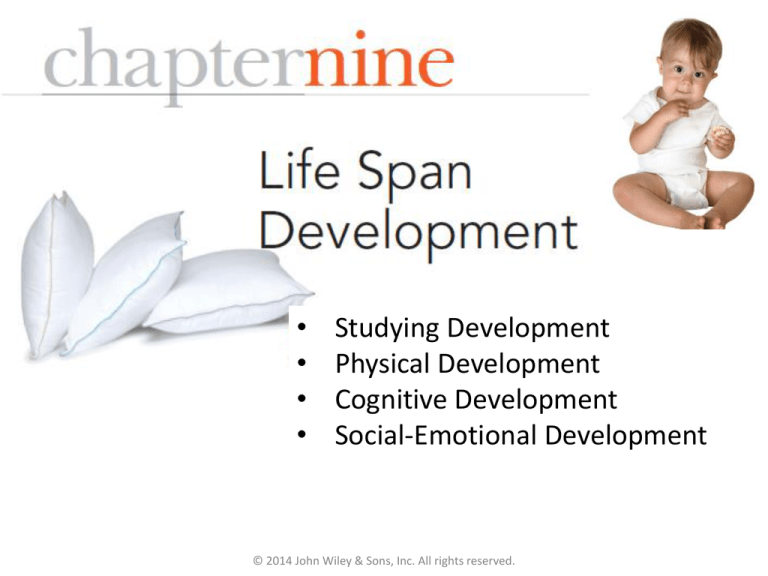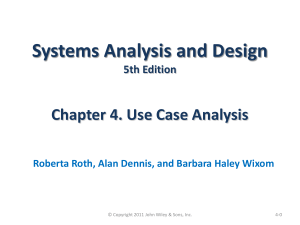
•
•
•
•
Studying Development
Physical Development
Cognitive Development
Social-Emotional Development
© 2014 John Wiley & Sons, Inc. All rights reserved.
Things You’ll Learn in Chapter 9
Q1
Are our childhood friends’ predictions of our adult
personality better than our own self-ratings?
Q2
Does prenatal exposure to smoke increase the risk of
obesity later in life?
Q3
Why do teenagers seem to sleep so much?
Q4
Do babies learn faster when they’re sitting up than
when they’re lying down?
Q5
Do today’s college students want women to propose
marriage?
© 2014 John Wiley & Sons, Inc. All rights reserved.
STUDYING DEVELOPMENT
© 2014 John Wiley & Sons, Inc. All rights reserved.
Theoretical Issues
• Developmental psychology = the study of agerelated changes in behavior and mental
processes and stages of growth, from
conception to death
© 2014 John Wiley & Sons, Inc. All rights reserved.
Three Major Issues
Nature or Nurture?
• How do both genetics (nature) and life experience
(nurture) influence development?
• Nature says development is governed by automatic,
genetically predetermined signals
– Maturation = the continuing influence of heredity throughout
development; age-related physical and behavioral changes
characteristic of a species
– Critical period = time of special sensitivity to specific types of
learning that shapes the capacity for future development
© 2014 John Wiley & Sons, Inc. All rights reserved.
Three Major Issues
Stages or continuity?
• Some developmental theories feature
stages that are discrete and relatively
different from each other
• Other theorists believe development
follows a continuous pattern with
gradual but steady and measureable
changes.
© 2014 John Wiley & Sons, Inc. All rights reserved.
Three Major Issues
Stability or change?
• Psychologists who emphasize stability say
measurements of personality in childhood are
important predictors of adult personality
• Psychologists who emphasize change disagree
© 2014 John Wiley & Sons, Inc. All rights reserved.
Research Approaches
• How to study the entire human life span?
• Cross-sectional design = A research technique that
measures individuals of various ages at one point in
time and provides information about age difference
• Longitudinal design = A research design that
measures a single individual or group of individuals
over an extended period and gives information about
age changes.
© 2014 John Wiley & Sons, Inc. All rights reserved.
Research Approaches
© 2014 John Wiley & Sons, Inc. All rights reserved.
Are our childhood friends’ predictions of our adult
personality better than our own self-ratings?
Martin-Storey et al., 2012
• 1976-1978: Researchers asked grade-school children to rate
themselves and their peers on personality factors like likeability,
aggression, social withdrawal
• 1999-2003: Researchers asked same participants to complete
tests again.
• Peer ratings were better than self-ratings in predicting adult
personality
Q1
Is this research crosssectional or longitudinal?
© 2014 John Wiley & Sons, Inc. All rights reserved.
Longitudinal vs. Cross-Sectional
Consider these results:
• Cross-sectional studies show
that intelligence and
reasoning peak in early
adulthood and then decline
• Longitudinal studies show
gradual increase in
intelligence and reasoning
until age 60 and then decline
© 2014 John Wiley & Sons, Inc. All rights reserved.
What might
explain the
difference in
the results?
PHYSICAL DEVELOPMENT
© 2014 John Wiley & Sons, Inc. All rights reserved.
Prenatal Development
• Germinal Period: From conception to
implantation
• Embryonic Period: From • Fetal Period:
implantation to 8 weeks
From 8 weeks to birth
© 2014 John Wiley & Sons, Inc. All rights reserved.
Prenatal Development
• Placenta connects fetus to mother’s uterus; serves as
link for food and waste; screens out some (but not all!)
harmful substances
• Teratogen = An environmental agent that causes
damage during prenatal development
– Greek word “teras” means “malformation”
– Crosses placental barrier
Does prenatal exposure to smoke increase
the risk of obesity later in life?
Children whose mothers smoked during pregnancy were more likely to
be obese as adults, perhaps due to increased preference for fatty
foods from nicotine exposure in the developing brain (Haghighi et al., 2013)
Q2
© 2014 John Wiley & Sons, Inc. All rights reserved.
Environmental Dangers
© 2014 John Wiley & Sons, Inc. All rights reserved.
Early Childhood: Brain Development
• Prenatal brain development
• Brain growth in first 2 years
© 2014 John Wiley & Sons, Inc. All rights reserved.
Early Childhood: Motor Development
• Motor development = orderly, observable
emergence of active movement skills
What factors
might affect the
speed with
which a baby
reaches each
milestone?
© 2014 John Wiley & Sons, Inc. All rights reserved.
Early Childhood: Sensory and
Perceptual Development
• Hearing is developed, with preference for mother’s voice
• Smell and taste are developed, with ability to distinguish
among sweet, salty, and bitter
• Touch and pain are highly developed (example: rooting
reflex)
• Vision is poorly developed, with vision worse
than 20/200 at birth; vision improves within
6 months to 20/100 and by age 2 is at
near-adult acuity
© 2014 John Wiley & Sons, Inc. All rights reserved.
Adolescence
• Adolescence is the psychological period between
childhood and adulthood
• Puberty = the biological changes during adolescence
that lead to an adult-sized body and sexual maturity
• Growth spurt includes rapid increase in size, weight, and
reproductive structures
Q3
Why do teenagers seem to sleep so much?
Puberty is triggered by changes in the brain
and the release of certain hormones that
occur only during deep sleep (Shaw et al., 2012)
© 2014 John Wiley & Sons, Inc. All rights reserved.
• Adolescence in the United States is typically the
teenage years
• Concept of adolescence varies across cultures
• In non-industrialized cultures, children assume
adult responsibilities as soon as possible, with
no need for slow transition
from childhood to adulthood
© 2014 John Wiley & Sons, Inc. All rights reserved.
Adulthood: Middle age
Women
• Menopause = the cessation
of the menstrual cycle;
occurs between 45 and 55
• Decreased production of
estrogen produces physical
and psychological changes
• Does not cause serious
psychological mood swings,
loss of sexual interest, or
depression
Men
• Gradual decline in hormone
levels
• Can continue to father
children into 70s or 80s
• Male climacteric or
andropause = weight gain,
loss of muscle strength,
decline in sexual
responsiveness, hair loss
• Midlife crisis is myth
© 2014 John Wiley & Sons, Inc. All rights reserved.
Adulthood: After middle age
• Gradual changes in heart, arteries and sensory
receptors
• Cardiac output decreases, blood pressure increases
• Visual acuity and depth perception decline; hearing
acuity declines; smell sensitivity declines
• Some decline in cognitive and memory skills
© 2014 John Wiley & Sons, Inc. All rights reserved.
Adulthood: After middle age
• Ageism = prejudice or discrimination based on
physical age; similar to racism and sexism in its
negative stereotypes
• Study of n = 1000 older adults
found increase in wellbeing
with age, contrary to negative
stereotypes (Jeste et al., 2012)
Supreme Court Justice
Ruth Bader Ginsberg
© 2014 John Wiley & Sons, Inc. All rights reserved.
COGNITIVE DEVELOPMENT
© 2014 John Wiley & Sons, Inc. All rights reserved.
Piaget: the Basics
• Schemas = the cognitive structures, framework, or
“blueprints” of knowledge, regarding objects, people
and situations, which grow and differentiate with
experience
• Assimilation = applying existing mental patterns
(schemas) to new information; new information is
incorporated (assimilated) into existing schemas
• Accommodation = the process of adjusting
(accommodating) existing mental patterns (schemas) or
developing new ones to fit better with new information
© 2014 John Wiley & Sons, Inc. All rights reserved.
Piaget’s Stages of Cognitive Development
• Remember, stage theories say development occurs in
discrete stages. Piaget said each stage is required and
leads to mastery of later stages
Q4
Do babies learn faster when they’re sitting up than
when they’re lying down?
• Babies were better at distinguishing
between objects they first explored
while sitting upright than when they
were lying down
• Why? The seated position may make babies better able
to reach for, hold, and manipulate objects
© 2014 John Wiley & Sons, Inc. All rights reserved.
Sensorimotor Stage
• Birth to approximately age 2
• Schemas are developed through
sensory and motor activities
• Object permanence = Piagetian term for an
infant’s recognition that objects (or people)
continue to exist even when they cannot be
seen, heard, or touched directly
– Gained during sensory/motor stage
© 2014 John Wiley & Sons, Inc. All rights reserved.
Preoperational Stage
• Roughly ages 2 to 7
• Ability to employ significant language
and to think symbolically
• Thinking is egocentric = the inability to take the
perspective of another person; assumes other see, hear,
feel, and think exactly as they do
• Thinking is animistic = belief that all things are living (or
animated)
• Lacks operations (reversible mental processes) – thus
“preoperational”
© 2014 John Wiley & Sons, Inc. All rights reserved.
Concrete Operational Stage
• Beginning approximately age 7
• Child can perform mental
operations on concrete objects and
understand reversibility and conservation, but
thinking is tied to concrete, tangible objects and
events
• Conservation = the understanding that certain
physical characteristics (such as volume) remain
unchanged, even though appearances may change
© 2014 John Wiley & Sons, Inc. All rights reserved.
Formal Operational Stage
• Beginning around age 11
• Can now apply operations to
abstract concepts and hypothetical
situations
• Imaginary audience = a form of egocentrism where
teenagers tend to believe everyone is thinking about
them, rather than wrapped up in their own concerns
• Personal fable = adolescents’ belief that they alone
have insights or difficulties that no one understands or
experiences
Unique and invulnerable?
What could go wrong?
© 2014 John Wiley & Sons, Inc. All rights reserved.
Personal Fable or Brain Development?
• Mood swings, poor
decisions, risky
behaviors previously
attributed to personal
fable may now be tied
to less developed
frontal lobe in
adolescents
© 2014 John Wiley & Sons, Inc. All rights reserved.
Vygosky vs. Piaget
• Vygotsky emphasized sociocultural
influence on child’s development,
especially the role of adult as
instructor
• Zone of proximal development
(ZPD) – the area between what
children can accomplish on their
own and what they can accomplish
with the help of others who are
more competent.
© 2014 John Wiley & Sons, Inc. All rights reserved.
Vygosky vs. Piaget
• Criticisms of Piaget
• Piaget underestimated abilities
– Research shows infants achieve object
permanence earlier than thought
– Research shows babies and preschoolers exhibit
non-egocentric responses
• Piaget underestimated genetic
and cultural influences
© 2014 John Wiley & Sons, Inc. All rights reserved.
SOCIAL-EMOTIONAL
DEVELOPMENT
© 2014 John Wiley & Sons, Inc. All rights reserved.
Attachment
• Attachment = a strong emotional
bond with special others that
endures over time
• Harlow’s studies of monkeys raised
by either a “cloth mother” or “wire
mother” showed monkeys preferred
contact with cloth mother
• Contact comfort, pleasurable tactile
sensations, is a powerful contributor
to attachment
© 2014 John Wiley & Sons, Inc. All rights reserved.
Attachment
• Mary Ainsworth
• “Strange situation” observed how infants
responded to the presence or absence of their
mother and a stranger in an unfamiliar setting
© 2014 John Wiley & Sons, Inc. All rights reserved.
Parenting Styles
© 2014 John Wiley & Sons, Inc. All rights reserved.
Moral Development
• Consider this situation:
– In Europe, a cancer-ridden woman was near
death, but an expensive drug existed that might
save her. The woman’s husband, Heinz, begged
the druggist to sell the drug cheaper or to let him
pay later. But he refused. Heinz became desperate
and broke into his store and stole it.
• Was Heinz right? Why or why not?
© 2014 John Wiley & Sons, Inc. All rights reserved.
Kohlberg’s Stages of
Moral Development
© 2014 John Wiley & Sons, Inc. All rights reserved.
Assessing Kohlberg’s Theory
• Do people high on Kohlberg’s scale act more
morally than others?
– Some research shows a person’s moral identity is a
good predictor of behavior in real-world situations
(Johnston, Sherman, & Grusec, 2013)
– Other research shows situational factors are better
predictors of moral behavior (Bandura, 1986, 1992, 2008)
© 2014 John Wiley & Sons, Inc. All rights reserved.
Personality Development
• Psychosocial stages = Erikson’s theory that
individuals pass through eight developmental
stages, each involving a specific crisis that must
be successfully resolved
•
•
•
•
Trust vs. mistrust
Autonomy vs. shame/doubt
Initiative vs. guilt
Industry vs. inferiority
•
•
•
•
Identity vs. role confusion
Intimacy vs. isolation
Generativity vs. stagnation
Ego integrity vs. despair
© 2014 John Wiley & Sons, Inc. All rights reserved.
Sex and Gender Influences
• How would you be different if you were a member of
the other sex?
• First, some definitions:
• Sex = biological characteristic determined at the
moment of conception
• Gender = psychological and sociocultural meanings
added to biological maleness or femaleness
• Gender roles = societal expectations for
“appropriate” male and female attitudes and
behaviors
© 2014 John Wiley & Sons, Inc. All rights reserved.
© 2014 John Wiley & Sons, Inc. All rights reserved.
Gender-Role Development
© 2014 John Wiley & Sons, Inc. All rights reserved.
Androgyny
• Androgyny = exhibiting both masculine and feminine
traits; from the Greek andro for “male” and gyn for
“female”
• Blending of masculine and feminine traits leads to
higher self-esteem and more success in complex
society (Bem, 1981, 1993)
• Gender roles are becoming less rigidly defined
© 2014 John Wiley & Sons, Inc. All rights reserved.
Androgyny
Q5
Do today’s college students want women to
propose marriage?
• Both men and women strongly prefer traditional
gender roles when it comes to marriage proposals,
even at a relatively liberal university in California
• More than 60% of women surveyed were at least
“somewhat willing” to take their husband’s name
(Robnett & Leaper, 2013)
• “Benevolent sexism” like this looks positive on the
surface but contributes to power differentials
between men and women (Lasnier, 2013)
© 2014 John Wiley & Sons, Inc. All rights reserved.
© 2014 John Wiley & Sons, Inc. All rights reserved.









